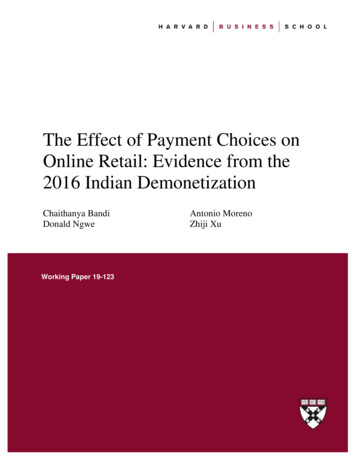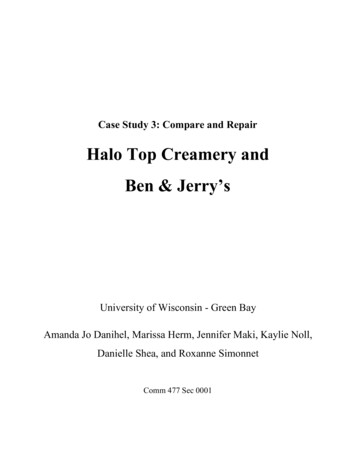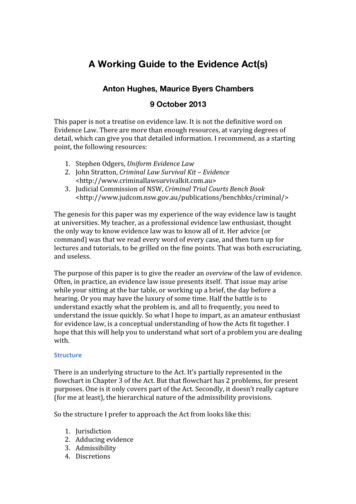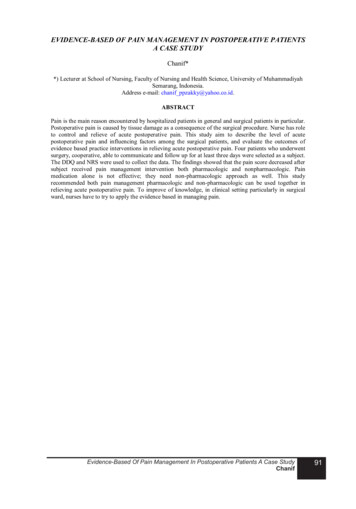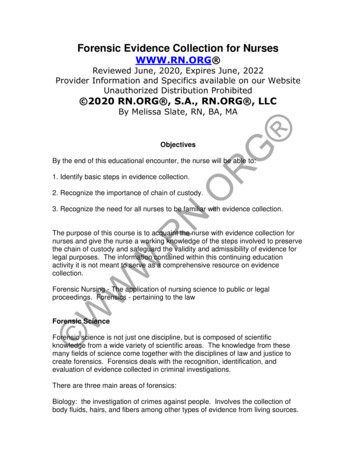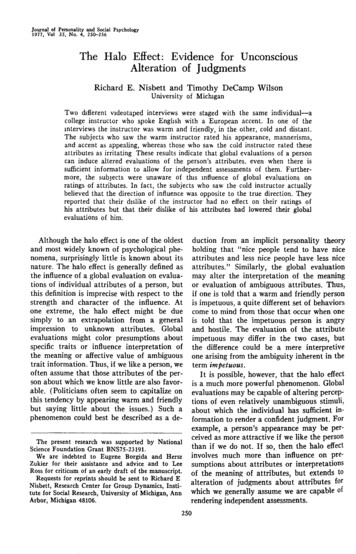
Transcription
Journal of Feisonality and Social Psychology1977, Vol 35, No. 4, 250-256The Halo Effect: Evidence for UnconsciousAlteration of JudgmentsRichard E. Nisbett and Timothy DeCamp WilsonUniversity of MichiganTwo different videotaped interviews were staged with the same individual—acollege instructor who spoke English with a European accent. In one of theinterviews the instructor was warm and friendly, in the other, cold and distant.The subjects who saw the warm instructor rated his appearance, mannerisms,and accent as appealing, whereas those who saw the cold instructor rated theseattributes as irritating These results indicate that global evaluations of a personcan induce altered evaluations of the person's attributes, even when there issufficient information to allow for independent assessments of them. Furthermore, the subjects were unaware of this influence of global evaluations onratings of attributes. In fact, the subjects who saw the cold instructor actuallybelieved that the direction of influence was opposite to the true direction. Theyreported that their dislike of the instructor had no effect on their ratings ofhis attributes but that their dislike of his attributes had lowered their globalevaluations of him.Although the halo effect is one of the oldestand most widely known of psychological phenomena, surprisingly little is known about itsnature. The halo effect is generally defined asthe influence of a global evaluation on evaluations of individual attributes of a person, butthis definition is imprecise with respect to thestrength and character of the influence. Atone extreme, the halo effect might be duesimply to an extrapolation from a generalimpression to unknown attributes. Globalevaluations might color presumptions aboutspecific traits or influence interpretation ofthe meaning or affective value of ambiguoustrait information. Thus, if we like a person, weoften assume that those attributes of the person about which we know little are also favorable. (Politicians often seem to capitalize onthis tendency by appearing warm and friendlybut saying little about the issues.) Such aphenomenon could best be described as a de-The present research was supported by NationalScience Foundation Grant BNS75-23191.We are indebted to Eugene Borgida and HerszZukier for their assistance and advice and to LeeRoss for criticism of an early draft of the manuscript.Requests for reprints should be sent to Richard ENisbett, Research Center for Group Dynamics, Institute for Social Research, University of Michigan, AnnArbor, Michigan 48106.duction from an implicit personality theoryholding that "nice people tend to have niceattributes and less nice people have less niceattributes." Similarly, the global evaluationmay alter the interpretation of the meaningor evaluation of ambiguous attributes. Thus,if one is told that a warm and friendly personis impetuous, a quite different set of behaviorscome to mind from those that occur when oneis told that the impetuous person is angryand hostile. The evaluation of the attributeimpetuous may differ in the two cases, butthe difference could be a mere interpretiveone arising from the ambiguity inherent in theterm impetuous.It is possible, however, that the halo effectis a much more powerful phenomenon. Globalevaluations may be capable of altering perceptions of even relatively unambiguous stimuli,about which the individual has sufficient information to render a confident judgment. Forexample, a person's appearance may be perceived as more attractive if we like the personthan if we do not. If so, then the halo effectinvolves much more than influence on presumptions about attributes or interpretationsof the meaning of attributes, but extends toalteration of judgments about attributes forwhich we generally assume we are capable ofrendering independent assessments.250
HALO EFFECT251The literature to date on the halo effectAnother type of experimental study hasdoes not provide a clear picture of either the employed actual persons as the stimuli (Clifstrength or the nature of the phenomenon. Al- ford & Walster, 1973; Dion, 1972; Dion,though correlational studies are plentiful, they Berscheid, & Walster, 1972; Miller, 1970),do not serve to demonstrate even that the but these studies suffice to show only the weakphenomenon exists. In any array of trait rat- "altered presumption" version of the halo efings, correlations tend to be positive, that is, fect because they provide extremely impoveraffectively consistent, but it is always possible ished information about the attributes to bethat the correlations are based on veridical rated. For example, Miller (1970) gave photosocial perception. For example, people with graphs of attractive and unattractive targetmore pleasant personalities may actually be persons to subjects and asked them to rate thebetter looking on the average than people with personalities of the target persons. Attractiveless pleasant personalities. Alternatively, peo- people were ascribed more favorable traitsple's criteria for likability and good looks may than unattractive people, but this merelydiffer in such a way as to produce positive constitutes a demonstration that people's imcorrelations in the absence of any influence of plicit personality theories include the assumpone judgment or the other. For example, a tion that physically attractive people havecollege football player and a drama major more attractive personalities. A convincingmay have different criteria for both likability demonstration of the strong version of theand good looks in other males. The football halo effect phenomenon would require givingplayer may prize a hail-fellow-well-met style subjects sufficient information on the attriand may regard brawn as essential to mascu- butes to be rated to allow for an independentline good looks. The drama major may favor assessment of the attributes.One study in the above tradition went subverbal wit and a lean, ascetic appearance. Ifan open personal style and brawniness are stantially further. Landy and Sigall (1974)associated and if a witty style and lean, as- showed that evaluations of an essay given bycetic looks are associated, then both the foot- male college students were substantiallyball player and the drama major might show higher when the alleged writer of the essaypositive correlations between their judgments was an attractive woman than when the alof likability and looks, even though they give leged writer was an unattractive woman. Thehigh scores on both dimensions to utterly dif- effect was very pronounced, especially whenferent people and even though neither judg- the essay was of relatively poor quality. Thisstudy supports the stronger interpretation ofment has in any way influenced the other.To demonstrate that global evaluations al- the halo phenomenon because, unlike theter evaluations of particular attributes re- attributes in the above studies, the subjectsquires an experimental approach. There have had information about the woman's essay thatbeen two sorts of experimental studies in this was entirely sufficient to allow for an indearea. One type employs adjectives rather than pendent assessment of its quality. The Landyand Sigall study, however, was not preciselypersons as the stimuli (e.g., Anderson, 1974;a study of the halo effect because it was aAsch, 1946). This research supports the gensingle attribute rather than a global evaluaeralization that the evaluative rating given totion that was manipulated and a person'sa trait adjective is a function of the totalproduct rather than an attribute that wasadjective set in which it is embedded. In ameasured.sense, then, the global evaluation alters theThe present experiment was designed toevaluation of a particular attribute. But thisaddressan additional issue—the question ofwork suffices only to show that the total adjective set may influence the meaning or eval- people's awareness of the halo effect. Nisbettuation of a particular adjective whose meaning and Wilson (1977) have recently argued thator value is somewhat ambiguous when con- people have little awareness of the nature orsidered in isolation, as in the example above even the existence of the cognitive processesof the interpretation of the adjective im- that mediate judgments, inferences, and theproduction of complex social behavior. ThePetuous.
252RICHARD E NISBETT AND TIMOTHY DECAMP WILSONhalo effect would appear particularly likelyto be such a subterranean, unrecognizedprocess. If people were capable of renderingindependent assessments of attributes, theywould surely do so. The halo effect, particularly if it is the strong, distorting influencepostulated by some theorists, would appearto depend upon lack of awareness for itsexistence. On the other hand, it is not inconceivable that subjects might actually be ableto report correctly on its operation if theywere directly questioned about it (e.g., Ohyes, now that you mention it, maybe part ofthe reason I liked his looks was because Iliked his personality). The present experimentdirectly assessed people's reports about thenature and direction of the influence of globalevaluations on evaluations of attributes.MethodOverviewCollege student subjects were asked to evaluate apsychology instructor, whom they viewed in a videotaped interview, on several dimensions The subjectswere told that the investigators were studying thepossibility that ratings of an instructor presented insuch a brief fashion might resemble ratings by students who had taken an entire course with the instructor The subjects were shown one of two different interviews with the same instructor, a nativeFrench-speaking Belgian who spoke English with afairly pronounced accent. In one interview, the instructor presented himself as a likable teacher, respectful of his students' intelligence and motives,flexible in his approach to teaching, and enthusiasticabout his subject matter In the other interview, heappeared to be quite unlikable, cold and distrustfultoward his students, rigid and doctrinaire in histeaching style. After viewing the videotaped interview, the subjects rated the instructor's likability,as well as the attractiveness of his physical appearance, his mannerisms, and his accent In order toexplore the question of subject awareness, some subjects were then asked whether the instructor's likability had affected their ratings of his appearance, mannerisms, and accent. Others were asked the reversequestion, namely, whether their evaluation of hisappearance, mannerisms, or accent had affected theirratings of his likability. It was anticipated that thesubjects would rate the instructor as having a moreattractive physical appearance, more attractive mannerisms, and a more attractive accent when he waslikable than when he was unlikable It was also anticipated that the subjects would be unaware of theseeffects on their judgments and would deny that theirglobal evaluation of the instructor had affected theirother ratings.ProcedureThe subjects were 118 University of Michigan students enrolled in introductory psychology; 62 weremales and 56 were females. The results for the twosexes were entirely similar and therefore were combined for presentation. The subjects participated inthe experiment in groups of 6-17. Sessions were conducted in such a way as to insure that no overtcommunication between subjects took place. (But inany case, conclusions are not affected when the grouprather than the individual was used as the unit ofanalysis.) On arrival, the subjects were ushered intoa well-appointed conference room with chairs orientedtoward a 19-inch (.48-meter) television monitor.The subjects were told that the psychology department had recently conducted a large-scale evaluationof teachers of introductory psychology:At the end of the term teachers were evaluated bytheir students on a number of dimensions, rangingfrom traditional questions of teaching effectivenessto questions about matters such as physical appearance and mannerisms We are interested infinding out whether evaluations of teachers whoare seen in brief videotaped interviews at all resemble the evaluations of these teachers by studentswho were exposed to them for a whole semester.We will ask you to look at these videotapes andthen rate the teachers on some of the same dimensions employed in the original study.The subjects were then shown two videotaped interviews All subjects were first shown a 7-minutefiller interview with a bright and pleasant instructorwho answered such questions as, What is your general educational philosophy? Do you encourage student discussion? How do you handle evaluations ofstudent work? Then half the subjects saw the Belgian instructor answer the same questions in hiswarm guise and half saw him answer the questionsin his cold guise Each of these interviews also lastedabout 7 minutes.The warmness or coldness of the instructor was apparent in his answers to virtually all the questionsFor example, in his warm guise the instructor answered the question about student discussion by saying that, yes, he encouraged discussion and that hewas stimulated by the give and take it provided andfelt that it enhanced student interest in the lecturematerial. In his cold guise he answered the questionby saying that he didn't allow much discussion because "there's a time to be a student and a time tobe a professor" and he wouldn't be the professor ifhe didn't know more than they did. In his warmguise the instructor answered the question aboutevaluation of student work by saying that he gavepaper assignments that the students seemed to likeand profit from and gave exams that were a mixtureof objective questions and thought questions. In hiscold guise he said he gave weekly multiple-choicequizzes because otherwise " y u can't trust them todo the reading."
HALO EFFECTDependent MeasuresAfter seeing each interview, all subjects were asked,"How much do you think you would like t
30.08.1976 · The halo effect, particu-larly if it is the strong, distorting influence postulated by some theorists, would appear to depend upon lack of awareness for its existence. On the other hand, it is not incon-ceivable that subjects might actually be able to report correctly on its operation if they were directly questioned about it (e.g., Oh yes, now that you mention it, maybe part of the reason I .
